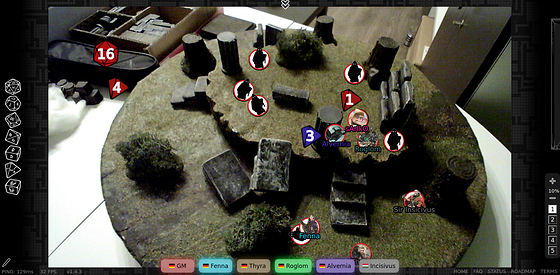First, ROGLOM (and all others of the Dakaerischer Bund game), don’t read further! 
Hey guys,
I’m running a group with up to 6 players (depending on the personal schedule, oddly sometimes everybody can make it). This runs me into a problem I’ve already encountered with other groups: My prepared scenes/rooms lead to very long playing time each. The players already try to take their turns quickly, so there’s no issue with that.
Why is that a problem for me?
I’m going with a 5 room dungeon approach to weave a story arc around each single session. That’s my personal goal as a GM; I want to “deliver” a coherent experience each game night. Especially because of the here-and-there-dropout of characters for some sessions.
Rearranging content (aka no content is left behind) isn’t always working well (at least for me), because one session ends without resolution and the next one starts with the resolution and needs to move into the next story bit… meh!
What do I mean by “very long playing time”?
For my players, 3.5 to 4 hours of gameplay is the sweetspot (concentration, staying attentive and awake). That means I’d like to split the game night into chunks of 40ish minutes, each with another scene to “fit” everything in. I don’t mean “fit” as “I want to play everything” but more than “I don’t want to skip things to go from the first encounter directly to the climax because of time”.
How does my prep look?
Regardless of group size, my prep contains of 5 blocks (each a scene) with 3-4 bullets each (including loot). That works perfect for my main group (2-3 players) within the given time frame … at least 80% of the time (in the remaining 20% I’mm delaying things into the next session… meh)
Prep for my yesterday game “The Ra’Hil-Temple” (as far as we went playing):
Ritual of Storms (Target 15)
- phylacteries feed magic storm
- magic storm destroys village of Felsbucht
- Cultists
+2 to checks, dagger, magic missile
- Sarech-amulet (WIS +1)
(meant as “Guardian Room”, because it’s about the destruction of Felsbucht, which forces the heroes to move on with their initial goal)
That scene was meant to be the previous session’s climax and we quit that session after the heroes charged the ritual spot. It took as around 1.5 hours to resolve that scene. A couple of heroes went down (one died, but the player is used to that). There were some cool things going around and finally the heroes won the upper hand.
Ruins of Felsbucht (Target 12)
- village elder ISAARO burried under debris
- recogniced TANERO-Cultists
- Ra’Hil-Temple is “gateway to the desert”
- Wineskin (3 uses, heal 1D4 HP)
(meant as “Challenge Room” to offer some knowledge how to get back on their track to the desert)
Compared to the combat scene, this small interlude was meant as a pure RP moment. The heroes dug out the guy, got some information and went to the abandoned mine, where the Ra’Hil-Temple was excavated. This turned out to be a quick one, just around the 40ish minutes mark. Everything fine here except for … see below resumee.
The Abandoned Mine (Target 15)
- shredded mine workers and mining gear
- Tunnelcrawler
+4 to checks, claws, acid pockets (destroy gear)
- dynamite (3 uses, gun effort)
- crates with 3x shabby loot
(meant as “Setback Room” before the climax of the adventure, making them face immense danger)
Some players really went nuts here: they played on their heroes’ fear about the abandoned tunnels after seeing the maimed corpses. When the timer hit down, crawler spawned and quickly revealed their acid property. To ramp up the danger and push them deeper into the mines, crawlers spawned from various tunnels. The heroes decided to stand firm and fight them one by one. As the session hit its lets-quit-threshold, we used the next spawn timer as a session end die, leaving the players(!) with the idea: “Maybe we should go instead of staying here”.
Resumee:
- My combat scenes take veeery long, because I’m either running many or spawning enemies. I have to find a way to keep the difficulty without extending the combat itself; basically they enjoy combat.
- Scenes without combat (like rescuing the village elder) are way easier on the time, but for me they feel without tension, because none of the heroes lives are at stake. It’s just like the “swamp” Hank mentioned a couple of times. I haven’t found “my way” of doing it. Also I fear, that they may take longer then. So I’m kind of happy with my way prepping them, but I plan on moderating them a bit differently (spotlight, staying in strict turns etc.)
What are your thoughts? Any ideas?



